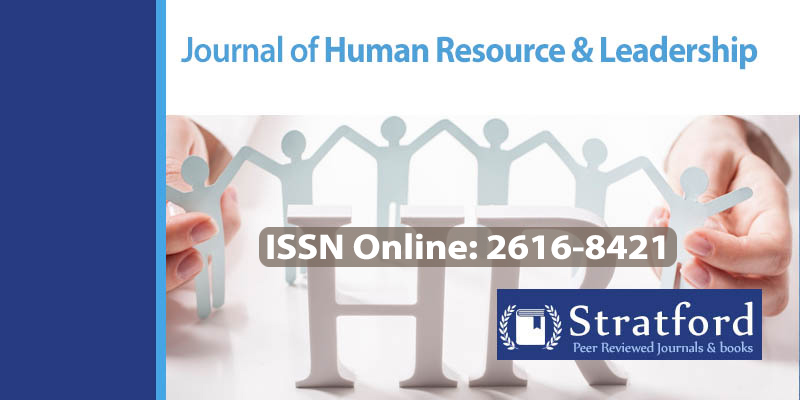Soft HRM Model: Human Capital as the Greatest Asset for Organizational Performance
Keywords:
HRM model, Human capital & Organizational performanceAbstract
There is no clearer time in the current generation that has demonstrated the significance of human capital in the world of work than in 2020 after the novel coronavirus (COVID-19) disease struck and eventually declared a global pandemic on 11 March 2020 (WHO, 2020). Governments across the world took up strict measures in a bid to tame spread of the highly infectious disease including initiating curfews and lockdowns. As a result, businesses, schools, factories and many institutions closed shop or reduced their operations significantly. Consequently, many companies have been left with buildings and infrastructure with no one to attend to them as most workers are quarantined or under lockdown in their homes, while others were asked to work from home. CEOs and managers have come to the appreciation of the fact that even with the most advanced machinery, seamless processes or well written policies and strategies, without the human resource to make use them for production then they remain unproductive with no income generation. With selected examples of best practices from various companies, this paper reflects on the importance of soft model of human resource management (HRM) in an organization.
References
Agbor, E. (2008). Creativity and Innovation: The Leadership Dynamics. Journal of Strategic Leadership, 39-45.
Armstrong, M., & Taylor, S. (2014). Armstrong’s Handbook of Human Resource Management Practice (13 ed.). London: Kopan Page.
Bandura, A. (1995). Self-Efficacy in Changing Societies. In A. Bandura, Self-Efficacy in Changing Societies (p. 1). UK: cambridge University Press.
Bolser, K., & Gosciej, R. (2015). Millennials: Multi-Generational Leaders Staying Connected. Journal of Practical Consulting, 1-9.
Burkus, D. (2010). Developing the Next Generation of Leaders: How to Engage Millennials in the Workplace. Leadership Advance Online(XIX).
Carmeli, A., & Spreitzer, G. (2009). Trust, Connectivity, and Thriving: Implications for Innovative Behaviors at Work. Journal of Creative Behavior, 27-49.
Cisco. (2018, July). Benefits and Perks. Retrieved July 20, 2018, from Cisco: https://www.cisco.com
CNN. (2015, 03 28). Lee Kuan Yew: Lessons for leaders from Asia's 'Grand Master'. Retrieved 05 17, 2020, from CNN: https://edition.cnn.com/2015/03/28/opinions/singapore-lee-kuan-yew-graham- allison/index.html
Daft, R. (2010). Organization Theory and Design (10 ed.). Mason, USA: South- Western, Cengage Learning.
Davis, G. (1999). Barriers to Creativity and Creative Attitudes. In m. Runco, & S. Pritzker, Encyclopedia of Creativity (pp. 165-174). San Diego: Academic Press.
Edgar, F., & Geare, A. (2005). HRM practice and employee attitudes: different measures –different results. Personnel Review, 534-549.
European Diversity Research & Consulting. (2010, Sept. 01). Colgate-Palmolive’s Commitment to Innovation. Retrieved from European Diversity Research & Consulting: http://en.diversitymine.eu/colgate-palmolives-commitment-to- innovation/
Forbes. (2013, May 22). The Top 5 Business Decisions of All Time. Retrieved from Forbes: https://www.forbes.com
Geue, P. (2017). Positive Practices in the Workplace: Impact on Team Climate, Work Engagement and Task Performance. Emerging Leadership Journey, 70-99.
Gratton, L., Hailey, V. H., Stiles, P., & Truss, C. (2011). Strategic Human Resource Management: Corporate Rhetoric and Human Reality. Oxford Scholarship Online.
Greatist. (2015, Oct. 2015). The 44 Healthiest Companies to Work for in America.
Retrieved July 21, 2018, from Greatist: https://greatist.com
Hoyes, M. (2014). Seeing Clearly – The First Tool for Leadership/Organizational Creativity. Journal of Strategic Leadership, 59-66.
ICPAK. (2018, 03 15). Continuing Professional Development Policy. Retrieved from ICPAK: https://www.icpak.com
ILO. (2018, July). Working Conditions. Retrieved July 20, 2018, from International Labour Organization: http://www.ilo.org/global/topics/working- conditions/lang--en/index.htm
Ivancevich, J., Konopaske, R., & Matteson, M. (2014). Organizational Behavior and Management (Tenth ed.). New York: McGraw-Hill.
Kopelman, R., Prottas, D., & Davis, A. (2008). Douglas McGregor's Theory X and Y: Toward a Construct-valid Measure. Journal of Managerial Issues, 255-271.
Kopelman, R., Prottas, D., & Falk, D. (2010). Construct validation of a Theory X/Y behavior scale. Leadership & Organization Development Journal, 120-135.
Leber, R. (2005). Unleashing Creativity in the Workplace: Going beyond the operations manual. Leadership Advance Online.
Livit, S. (2007). Are You Really Listening? Delivering What Your Client Really.
Journal of Practical Consulting, 37-39.
Miron, E., Erez, M., & Naveh, E. (2004). Do Personal Characteristics and Cultural Values That Promote Innovation, Quality, andEfficiency Compete or Complement Each Other? Journal of Organizational Behavior, 175-199.
Mostovicz, I., Kakabadse, N., & Kakabadse, A. (2009). A dynamic theory of leadership development. Leadership & Organization Development Journal, 563-576.
Nasir, S. Z. (2017). Emerging Challenges of HRM in 21st Century: A Theoretical Analysis. International Journal of Academic Research in Business and Social Sciences, 216-223.
Network Capital Funding Corporation. (2017). An Award-Winning Employer. Retrieved July 20, 2018, from Network Capital Funding Corporation: https://www.networkcapital.net
Ngugi, B., Pelowski, M., & Ogembo, J. G. (2010). M-Pesa: A Case Study of the Ctritical Early Adopters'Role in the Rapid Adoption of Mobile Money Banking in Kenya. The Electronic Journal of Information Systems in Developing Countries, 1-16.
Ogochi, D. K. (2018). Authentic Leadership: Its Significance in Developing Authentic Leadership Practices. Journal of Human Resource & Leadership, 63-89.
Rana, M. H., & Malik, M. S. (2017). Impact of human resource (HR) practices on organizational performance: Moderating role of Islamic principles. International Journal of Islamic and Middle Eastern Finance and Management, 186-207.
Reytheon Company. (2017). Benefits: Work/Life. Retrieved July 20, 2018, from Raytheon Company: https://jobs.raytheon.com
Safaricom Limited. (2018). M-Pesa. Retrieved July 21, 2018, from Safaricom Limited: https://www.safaricom.co.ke
Truss, C., Gratton, L., Hope-Hailey, V., McGovern, P., & Stiles, P. (1997). Journal of Management Studies. Soft and Hard Models of Human Resource Management: A Reappraisal, 53-73.
UN Global Compact. (2020). The Ten Principles of the UN Global Compact. Retrieved 05 11, 2020, from UN Global Compact: https://www.unglobalcompact.org
WHO. (2020, 05 11). Rolling updates on coronavirus disease (COVID-19). Retrieved from WHO: https://www.who.int
Wiltshire, E. D. (2011). Temperance and Organizational Leadership: Control Yourself before Trying to Control Others. Regent University .
Winston, B., & Patterson, K. (2006). An Integrative Definition of Leadership.
International Journal of Leadership Studies, 6-66.
Wong, P., & Davey, D. (2007). Best Practices in Servant Leadership. Servant Leadership Research Roundtable, 1-15.


